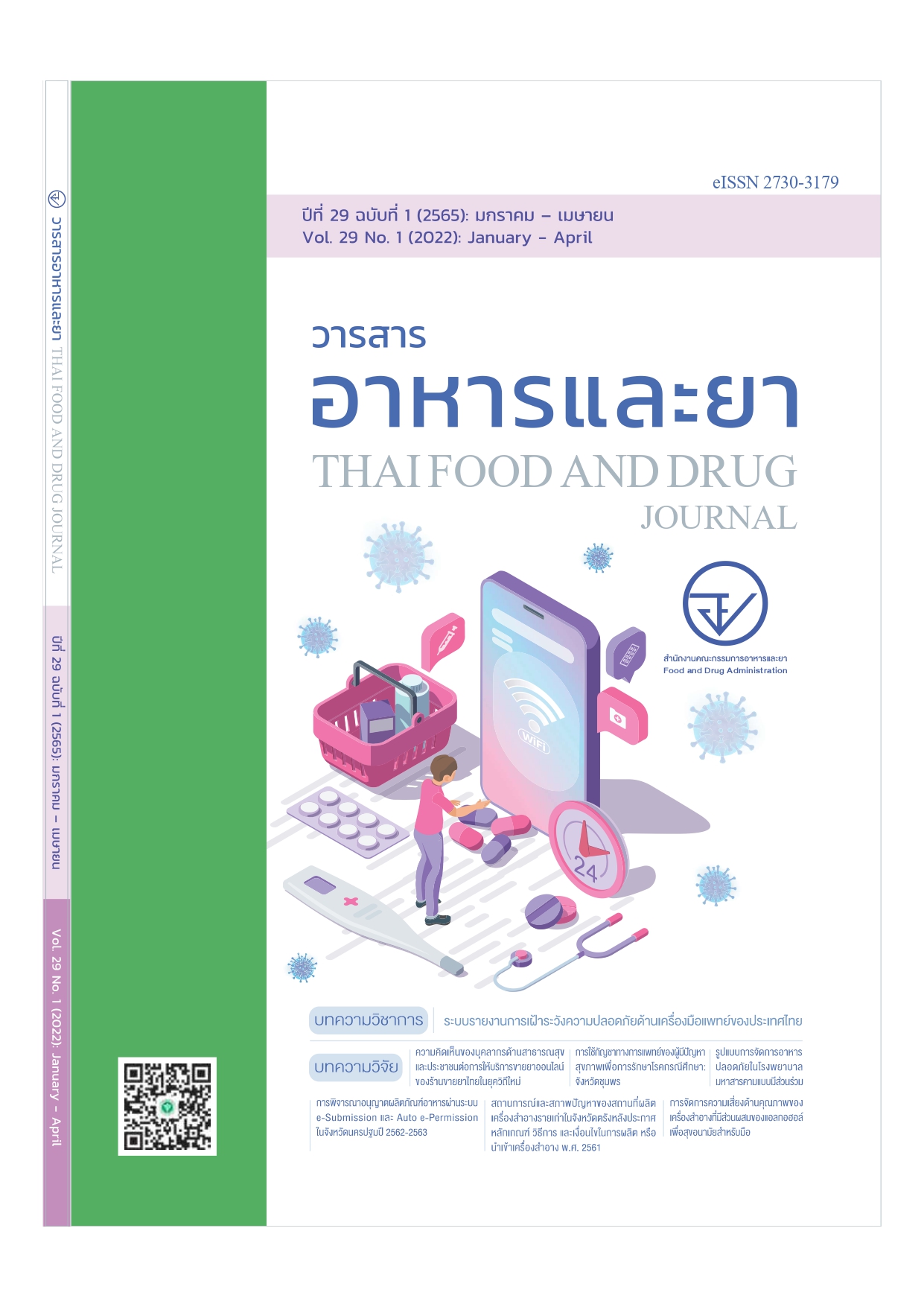รูปแบบการจัดการอาหารปลอดภัยในโรงพยาบาลมหาสารคามแบบมีส่วนร่วม
Main Article Content
บทคัดย่อ
ความสำคัญ: โรงพยาบาล (รพ.) จำเป็นต้องผลิตอาหารที่ปลอดภัยสำหรับผู้ป่วย ญาติผู้ป่วย และผู้มารับบริการ เพื่อไม่ให้ได้รับสารพิษหรือเชื้อโรคที่ปนเปื้อนซึ่งจะก่อให้เกิดโทษหรือกระทบต่ออาการป่วยที่เพิ่มขึ้น จึงต้องมีการควบคุมกำกับเพื่อความปลอดภัยของอาหารใน รพ. โดยใช้การมีส่วนร่วมของเครือข่ายที่เกี่ยวข้องตลอดห่วงโซ่อาหาร
วัตถุประสงค์ เพื่อสร้างรูปแบบการจัดการอาหารปลอดภัยใน รพ. มหาสารคาม และศึกษาผลกระทบหลังการจัดการอาหารปลอดภัย
วิธีการวิจัย: เป็นการศึกษาเชิงปฏิบัติการแบบมีส่วนร่วม ตั้งแต่ตุลาคม พ.ศ. 2560 – กันยายน พ.ศ. 2563 ในโรงครัว ศูนย์จำหน่ายอาหาร สหกรณ์ร้านค้า พื้นที่ขายสินค้าเกษตรปลอดสารใน รพ. มหาสารคาม และพื้นที่แปลงเกษตรอินทรีย์ในจังหวัดมหาสารคาม คัดเลือกกลุ่มตัวอย่างแบบเจาะจงจากเกษตรกร 43 คน ผู้ป่วย 120 คน และผู้สัมผัสอาหาร 70 คน วิเคราะห์ข้อมูลเชิงพรรณนา ได้แก่ จำนวน ร้อยละ ค่าเฉลี่ย ส่วนเบี่ยงเบนมาตรฐาน Paired-t-test และ Wilcoxon signed rank test และข้อมูลเชิงคุณภาพด้วยการวิเคราะห์แก่นสาระ (thematic analysis)
ผลการศึกษา: พบว่ารูปแบบในการพัฒนาการจัดการอาหารปลอดภัยใน รพ. คือ “MSKH Food safety model” มีการจัดการตลอดห่วงโซ่อาหาร ตั้งแต่ต้นทาง (การจัดการวัตถุดิบปลอดภัยในการผลิต) กลางทาง (การตรวจสอบวัตถุดิบ การเฝ้าระวังความปลอดภัยของอาหาร การตรวจสอบมาตรฐานสุขาภิบาล) ปลายทาง (เมนูชูสุขภาพปลอดภัย เมนูอัตลักษณ์ของ รพ. การสร้างความรอบรู้ให้ผู้บริโภค การจัดพื้นที่ให้ผู้บริโภคเข้าถึงอาหารปลอดภัยเพื่อสร้างวัฒนธรรมการบริโภคอาหารปลอดภัย) ทำให้มีการใช้วัตถุดิบปรุงประกอบอาหารให้ผู้ป่วยประเภทผักปลอดสารพิษอินทรีย์เข้าโภชนาการ รพ. สูงถึงร้อยละ 75.24 ข้าวอินทรีย์ร้อยละ 100.00 เกิดเมนูอาหารปลอดภัยที่ใช้วัตถุดิบจากผักปลอดสารถึงร้อยละ 32.00 มีการจัดซื้อวัตถุดิบผัก ผลไม้ ข้าวอินทรีย์จากเกษตรกรในพื้นที่ คิดเป็นมูลค่า 4,393,762.00 บาท (หลังดำเนินการปี พ.ศ. 2561-2563 ส่วนก่อนดำเนินการปี พ.ศ. 2560 มีมูลค่า 0 บาท) ทำให้เกิดการขับเคลื่อนเศรษฐกิจให้กับพื้นที่ การตรวจสอบสารปนเปื้อนในอาหารทุกพื้นที่ดำเนินการพบสารปนเปื้อนลดลงอย่างต่อเนื่องในปี พ.ศ. 2560–2563 จากร้อยละ 15.36 เป็น 1.19 คะแนนความรอบรู้อาหารปลอดภัยและมาตรฐานสุขาภิบาลอาหารก่อนและหลังพัฒนาศักยภาพกลุ่มตัวอย่าง พบว่ามีคะแนนเฉลี่ยเพิ่มขึ้นทุกด้านในระดับ “ดีมาก” อย่างมีนัยสำคัญทางสถิติ (ก่อน 12.27 และหลัง 17.67 จาก 20 คะแนน, p=0.0001) และพบว่าเกษตรกรมีเอนไซม์โคลีนเอสเตอเรสในเลือดดีขึ้นอยู่ในระดับปกติอย่างมีนัยสำคัญทางสถิติที่ p=0.05
สรุป: การพัฒนา รพ. มหาสารคามอาหารปลอดภัยได้สร้างรูปแบบการมีส่วนร่วมการจัดการอาหารปลอดภัย ส่งผลต่อการเปลี่ยนแปลงการจัดการอาหารใน รพ. ครบวงจรห่วงโซ่อาหาร สามารถพัฒนาความปลอดภัยด้านอาหารและสุขาภิบาลอาหาร รวมถึงความรอบรู้ด้านสุขภาพ รูปแบบการจัดการนี้ทำให้เกิดสุขภาวะประชาชนแบบองค์รวมทั้งด้านสุขภาพ เศรษฐานะ และความรอบรู้ด้านสุขภาพในการดูแลตนเองได้อย่างมั่นคง มั่งคั่ง และยั่งยืน
Article Details

อนุญาตภายใต้เงื่อนไข Creative Commons Attribution 4.0 International License.
เอกสารอ้างอิง
1.Sanborn M, Cole D, Kerr K, Vakil C, Sanin LH, Bassil K. Systematic review of pesticide human health effects. OCFP [Internet]. 2004;1-177. Available from: https://www.researchgate.net/publication/277291279_Systematic_Review_of_Pesticide_Human_Health_Effects
2.National Research Council. Toxicity testing: strategies to determine needs and priorities. Washington DC: National Academy; 1984.
3.สถาบันมะเร็งแห่งชาติ. ทะเบียนมะเร็งระดับโรงพยาบาล พ.ศ. 2562. กรุงเทพฯ: นิวธรรมดา; 2563.
4.กองบริหารการสาธารณสุข กระทรวงสาธารณสุข. มาตรฐานโรงพยาบาลอาหารปลอดภัย. พิมพ์ครั้งที่ 2. สมุทรสาคร: บอร์น ทู บี พับลิชชิ่ง; 2560.
5.กฤษฎา หาญบรรเจิด, เกียรติศักดิ์ แหลมจริง. ผลการประเมินโครงการโรงพยาบาลอาหารปลอดภัย. วารสารสถาบันบำราศนราดูร 2563;14(1):45-55.
6.Bloom BS. Handbook on formation and Summative Evaluation of Student Learning. New York: McGraw-Hill Book; 1971.
7.กรมควบคุมโรค. แบบประเมินความเสี่ยงในการทำงานของเกษตรกรจากการสัมผัสสารเคมีกำจัดศัตรูพืช. [อินเทอร์เน็ต]. 2556 [เข้าถึงเมื่อ 16 ก.พ. 2564]. เข้าถึงได้จาก http://envocc.ddc.moph.go.th /uploads/31858/1-56.pdf
8.ศิริพล ภูปุย, มนต์กานต์ อินทรกำแหง. การพัฒนาการดำเนินงานอาหารปลอดภัยในตลาดชุมชน ตำบลโพน อำเภอคำม่วง จังหวัดกาฬสินธุ์. วารสารวิจัยทางวิทยาศาสตร์สุขภาพ 2559;10(2):50-9.
9.กนกพร ธัญมณีสิน. ระบาดวิทยาของการปนเปื้อนฟอร์มาลินในอาหารสดในบางจังหวัดของภาคตะวันออกเฉียงเหนือ ปีงบประมาณ 2557. วารสารเภสัชกรรมไทย 2558;7(1):31-7.


